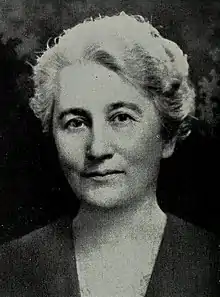Gertrude L. Warren | |
|---|---|
 | |
| Born | 1884 |
| Died | September 6, 1979 |
| Alma mater | Columbia University |
| Known for | 4-H |
Gertrude L. Warren (1884–1979) was an American government official and a pioneer in the 4-H movement.
Early life and family
Gertrude L. Warren was born on a farm near Lockport, New York.[1] She studied at Columbia University, from which she received bachelor's and master's degrees in home economics.[1]
Career
Warren taught home economics at Columbia until 1917, at which time she moved to Washington, D.C. to join the United States Department of Agriculture (USDA) as a senior scientist. She was placed in charge of the home-making element of a network of boys' and girls' clubs,[1] organized under the Cooperative Extension Service. The first appearance of the term "4-H Club" in a federal document was in "Organization and Results of Boys' and Girls' Club Work," by Oscar Herman Benson (1875–1951) and Warren, in 1920.[2] (The expression had been used in a speech by Benson as early as 1911.[3]) Warren advocated for this name for the program; others proposed "Junior Extension Work," with reference to other federal programs. By 1924, the system was known as 4-H,[4] for its emphasis on improving head, heart, hands, and health.[5] When Warren joined USDA, membership in the clubs numbered 330,000; at her retirement in 1952, the system had grown to 85,000 clubs with 2 million members.[1] Warren expanded the scope of girls' activities under the program (promoting garment making, room decorating, and hot lunches), and wrote extensive training materials.[6][7]
Warren was instrumental in establishing the National 4-H Foundation (now the National 4-H Council) and the National 4-H Center in Washington.[1] She initiated the International Four-H Youth Exchange.[1] Warren was a member of the Commission on Child Welfare, established by Herbert Hoover; the Eighth Scientific Conference of the Americas; the Rural Education Conference for Franklin D. Roosevelt; and Harry S. Truman's National Youth Emergency Conference and Conference on Family Life.[1] To sum up her career, she was called "the mother of 4-H"[1][8] and "the guardian angel of 4-H."[6]
Outside of government, Gertrude L. Warren was president of the Woman's National Farm & Garden Association from 1952 to 1954.[9]
Later life and death
Gertrude L. Warren died of cardiac arrest on 6 September 1979 at Sibley Memorial Hospital in Washington.[1]
Legacy and recognition
For her work in establishing 4-H Clubs in Latvia, Gertrude Warren (along with Ray A. Turner and C. B. Smith) was awarded the Order of the Three Stars, that country's highest civil order.[10] At the National 4-H Conference Center in Chevy Chase, Maryland, the headquarters building was named Warren Hall in her honor.[1]
Selected publications
- Benson, Oscar Herman; Warren, Gertrude L. (February 1920). Organization and Results of Boys' and Girls' Club Work (Northern and Western States): 1918. Washington, DC: U.S. Department of Agriculture. Retrieved 21 August 2018. Department Circular 66
- Warren, Gertrude L. (April 1936). The Cultural Aspects of 4-H Club Work. Washington, DC: U.S. Department of Agriculture, Extension Service. Retrieved 8 August 2018. Extension Service Circular 241
- Warren, Gertrude L. (October 1938). Organization of 4-H Club Work: A Guide for Local Leaders. Washington, DC: U.S. Department of Agriculture. Retrieved 8 August 2018. Miscellaneous Publication No. 320
- Warren, Gertrude L. (July 1951). Building a Better America through the 4-H Clubs. Washington, DC: U.S. Department of Agriculture, Extension Service. Retrieved 8 August 2018. AIB 58
- Warren, Gertrude L. (December 1952). Aids for Observance of National 4-H Club Events. U.S. Department of Agriculture, Extension Service. Retrieved 8 August 2018. PA-214
References
- 1 2 3 4 5 6 7 8 9 10 Joyce, Maureen (8 September 1979). "Gertrude Warren Dies: 'Mother of 4-H'". Washington Post. Retrieved 6 August 2018.
- ↑ Reck (1951), p. 210.
- ↑ Reck (1951), p. 96.
- ↑ Reck (1951), p. 211.
- ↑ Reck (1951), p. 98.
- 1 2 "Folks Who Helped Make 4-H Great: Gertrude Warren". National 4-H History Preservation Program. 8 March 2016. Retrieved 8 August 2018.
- ↑ Reck (1951), pp. 166–168.
- ↑ "Elsie Carper Collection on Extension Service, Home Economics, and 4-H". National Agricultural Library Special Collections. United States Department of Agriculture. Retrieved 21 August 2018.
- ↑ Nolan (1985), pp. 72, 266.
- ↑ Wessel & Wessel (1982), p. 137.
Bibliography
- Nolan, Martha A. (1985). A Chronicle: The History of Woman's National Farm & Garden Association, Incorporated: 1914-1984. OCLC 924193250.
- Reck, Franklin A. (1951). The 4-H Story: A History of 4-H Club Work (PDF). Chicago, IL: National 4-H Service Committee. OCLC 950057521.
- Wessel, Thomas; Wessel, Marilyn (1982). 4-H: An American Idea, 1900-1980. Chevy Chase, MD: National 4-H Council. OCLC 8675452.